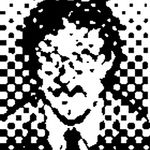- Home
- Illustrator
- Discussions
- Betreff: How do I make the outline of a traced ima...
- Betreff: How do I make the outline of a traced ima...
How do I make the outline of a traced image all the same width?
Copy link to clipboard
Copied
Explore related tutorials & articles
Copy link to clipboard
Copied
In this example you cannot, too much noise in your line.
Manually tracing with the pen tool will give the cleanest results.
Copy link to clipboard
Copied
You could trace this just normally. Then release the compound path, delete one of the paths and then apply Object > Path > Offset path to the other path.
You could also try if it works tracing this as a stroke.
Copy link to clipboard
Copied
I tried both approaches but they result in a mess. The image and the line is not clean and contains too much noise.
Copy link to clipboard
Copied
Just drawing it will be the best. But I think it's doable
Copy link to clipboard
Copied
Yes it is doable with a lot of work and knowledge.
If you know how to do this, you probably also know how the pen tool works.
Copy link to clipboard
Copied
Wow!!! Thank you for your quick response. I think you did exactly what I need to do, but I can't follow it on your YouTube because it's in German, I think. I'm in the U.S.What I'm trying to accomplish is being able to trace a shape, convert it to a vector, then change it to a SVG file so I can use it on my laser cutter. I need a fine clean line. Is there a way to trace a new line over the one we're working on here?
All the best, DanDan Taglia (link removed by moderator)
Copy link to clipboard
Copied
@Dan Taglia schrieb:
because it's in German, I think.
Yes that is German.
Bildnachzeichner = Image Trace (Window menu)
Vereinfachen = Simplify (Object menu)
Zusammengesetzter Pfad = Compound path (Object menu)
The method will only work on simple shapes. As soon as you have lines that cross or meet, it will fail.
Copy link to clipboard
Copied
Dan,
"What I'm trying to accomplish is being able to trace a shape, convert it to a vector, then change it to a SVG file so I can use it on my laser cutter."
Presuming that your preferred workflow is to draw things by hand and then convert it using Live Trace , also for future tasks, it is really worth starting out in the right way.
Firstly, a pen with a strong solid line would give a completely different basis for the tracing. The appearance of the line in this case varies greatly between strong and (very) faint.
Secondly, a(n almost) fully white/uniform background would remove (almost all) the unnecessary cleanup outside the actual drawn line and at the same time further improve the tracing of the line by allowing a much greater range of trace settings, not least the Threshold (Schwelle), maybe obtained with a reasonable/good scanner or with better lighting in connexion with photos. The background has a conspicuos colour transition and is far from white, the colour of the nearest parts (too) close to the faintest parts of the line.
Find more inspiration, events, and resources on the new Adobe Community
Explore Now

